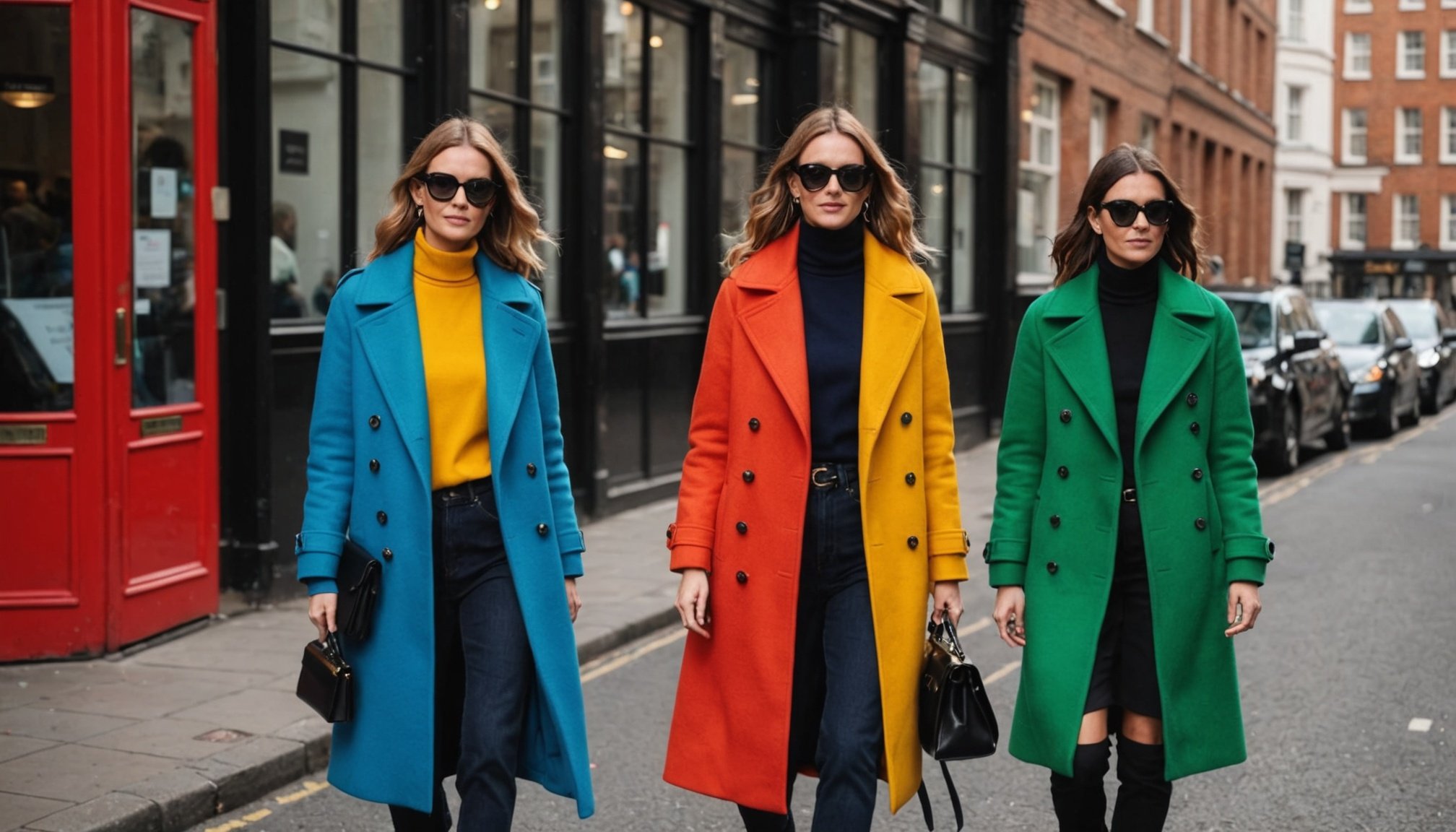Winter Fashion in London: Unlock the Art of Color Blocking with These Expert Tips!
As the chill of winter sets in, London’s fashion scene comes alive with a vibrant and eclectic mix of styles that defy the monotony of cold-weather attire. One of the most compelling and effective ways to transform your winter wardrobe is through the art of color blocking. In this article, we will delve into the world of color blocking, exploring its history, practical styling tips, and how to incorporate this technique into your winter fashion repertoire.
Understanding Color Blocking for Winter
Color blocking has a rich history in fashion, dating back to the 1960s when it first gained prominence. This technique involves combining solid, contrasting colors to create a striking visual statement. In the context of winter fashion, color blocking serves both a functional and aesthetic purpose. It breaks up the monotony of muted winter colors and introduces a liveliness that is particularly welcome during the cold season[1].
Also read : Essential tips for preserving luxury footwear in wet uk conditions: maximize their lifespan!
The Role of Color Blocking in Winter Fashion
In London, where fashion is often a blend of playful and sophisticated designs, color blocking aligns perfectly with current winter fashion trends. It allows individuals to craft unique and eye-catching winter wardrobes that reflect their personal style. For instance, pairing a bright yellow coat with neutral-toned trousers can make a visually impactful statement without overwhelming the entire ensemble[1].
Styling Techniques for Color Blocking
Effective styling is crucial when it comes to color blocking, especially in winter. Here are some expert tips to help you master this technique:
Also read : Top tips for choosing the perfect bridal headpiece for your winter wedding in the uk
Layering without Bulk
Layering is essential for winter wardrobe essentials, but it can be challenging to layer color-blocked pieces without adding bulk. Here’s how you can do it:
- Start with a Base Layer: Begin with a lightweight, fitted color-blocked sweater.
- Add a Tailored Coat: Top it with a tailored coat that complements the colors of your sweater.
- Balance with Neutrals: Pair with neutral-toned trousers or a skirt to maintain a structured silhouette.
This approach ensures you stay warm and stylish without looking bulky[1].
Accessorizing for Color Balance
Accessories can significantly enhance any color-blocked look by providing the perfect balance between colors. Here are some tips:
- Select Complementary Colors: Choose winter accessories such as scarves or hats in a hue from your primary color block.
- Add a Pop of Color: A scarf or hat in a complementary color can create a cohesive look while injecting an extra pop of color.
- Consider the Intensity: Ensure the intensity of the colors in your accessories complements the overall outfit without overwhelming it[1].
Creating Visual Interest through Texture
Incorporating varying textures within your outfit can add depth without overwhelming the color palette. Here’s how you can do it:
- Mix Materials: Combine materials like wool, silk, or leather to add texture.
- Balance with Neutrals: Ensure the textures are balanced with neutral elements to avoid overwhelming the outfit.
- Example: Pair a wool sweater with silk trousers and leather boots for a stylish and visually stimulating ensemble[1].
Inspiration from London Fashion
London’s fashion scene is a treasure trove of color blocking examples, showcasing how this vibrant technique is embraced in street style. Here are some key takeaways:
Street Style Examples
- Bold Outerwear: Londoners often pair vibrant outerwear with subdued accessories. For example, a bright pink tailored coat paired with neutral-toned trousers can make a striking statement[1].
- Fashion Influencers: Fashion influencers in London are adept at crafting color blocking looks that captivate. They expertly manipulate the intensity of colors and their placement within the outfit to create eye-catching yet sophisticated looks[1].
Notable Brands
- Traditional British Aesthetics: Brands like Hobbs London blend traditional British aesthetics with bold color schemes to create memorable collections. For instance, Hobbs London’s Carine Wool Coat in bright pink is a conversation starter and a perfect example of how color blocking can be both stylish and functional[2].
Practical Tips for Staying Warm and Stylish
While embracing color blocking in winter fashion, it’s crucial to consider staying warm without compromising on style. Here are some practical tips:
Heat Retention Strategies
- Layering: Start with a thermal base layer, then add a color-blocked piece like a wool sweater, and finally top it with an insulated coat. This layering ensures efficient heat retention while enhancing your color palette[1].
- Fabric Choices: Opt for materials like merino wool, cashmere, and fleece that trap heat while maintaining a polished look. These fabrics are breathable and help regulate temperature[1].
Importance of Fabrics
- Natural Materials: Materials such as wool and cashmere are ideal for winter as they provide warmth without compromising on style.
- Synthetic Options: Fleece and other synthetic materials can also be effective, especially when combined with natural fibers.
Weather-Appropriate Choices
- Waterproof Layers: Incorporate waterproof layers or wind-resistant fabrics into your wardrobe to adapt to London’s unpredictable climate.
- Functional Accessories: Choose accessories like raincoats or foldable hats that are both stylish and functional[1].
Detailed Guide to Color Blocking
Here is a detailed guide to help you get started with color blocking:
Color Combinations
Here are some inspiring color combinations to try:
- Monochromatic: Use different shades of the same color to create a cohesive look.
- Example: Pair a light blue sweater with darker blue trousers and a navy blue coat.
- Complementary: Pair colors that are opposite each other on the color wheel.
- Example: Combine red with green or blue with orange.
- Analogous: Use colors that are next to each other on the color wheel.
- Example: Pair blue with green and yellow.
Layering Tips
Here’s a step-by-step guide to layering for color blocking:
- Base Layer: Start with a thermal base layer in a neutral color.
- Mid-Layer: Add a color-blocked sweater or cardigan.
- Outer Layer: Top it with a tailored coat that complements the colors of your mid-layer.
- Accessories: Add accessories like scarves or hats in a hue from your primary color block.
Texture and Fabric
Here’s how to incorporate texture and fabric into your color-blocked outfit:
- Mix Materials: Combine different materials like wool, silk, and leather.
- Balance with Neutrals: Ensure the textures are balanced with neutral elements to avoid overwhelming the outfit.
- Example: Pair a wool sweater with silk trousers and leather boots.
Table: Comparing Different Color Blocking Techniques
| Technique | Description | Example | Tips |
|---|---|---|---|
| Monochromatic | Using different shades of the same color | Light blue sweater, darker blue trousers, navy blue coat | Ensures a cohesive look |
| Complementary | Pairing colors opposite each other on the color wheel | Red with green or blue with orange | Creates a striking contrast |
| Analogous | Using colors next to each other on the color wheel | Blue with green and yellow | Provides a harmonious transition between colors |
| Layering | Layering different pieces to create depth | Thermal base layer, color-blocked sweater, tailored coat | Ensures warmth and style |
| Texture Mixing | Combining different materials | Wool sweater, silk trousers, leather boots | Adds depth without overwhelming the color palette |
Quotes and Insights from Fashion Experts
- “Color blocking is a great way to add visual interest to your outfit. It’s all about balancing bold colors with neutrals to create a cohesive look,” says Emili, a Scandi style star[2].
- “Incorporating color blocking into your winter wardrobe can be both stylish and functional. It’s about finding the right balance between colors and textures,” notes a fashion influencer from London[1].
Practical Tips for Your Capsule Wardrobe
Here are some practical tips to incorporate color blocking into your capsule wardrobe:
Start Small
- Begin with a few key pieces that can be mixed and matched to create multiple outfits.
- Example: A bright yellow sweater can be paired with neutral-toned trousers or a skirt.
Invest in Quality
- Invest in high-quality, versatile pieces that can be worn multiple times.
- Example: A tailored coat in a neutral color can be paired with various color-blocked sweaters.
Accessorize Wisely
- Use accessories to enhance your color-blocked look.
- Example: A scarf or hat in a complementary color can add a pop of color to your outfit.
Color blocking is a powerful tool in winter fashion, allowing you to create visually appealing outfits that break the monotony of cold-weather attire. By understanding the history of color blocking, mastering styling techniques, and drawing inspiration from London’s fashion scene, you can transform your winter wardrobe into a vibrant and stylish reflection of your personal style.
Remember, the key to successful color blocking is balance and harmony. Experiment with different color combinations, textures, and fabrics to find what works best for you. With these expert tips, you’ll be well on your way to creating a winter wardrobe that is both bold and seasonal.
So, don’t let the cold weather dull your fashion sense. Embrace the art of color blocking and make this winter your most stylish yet








